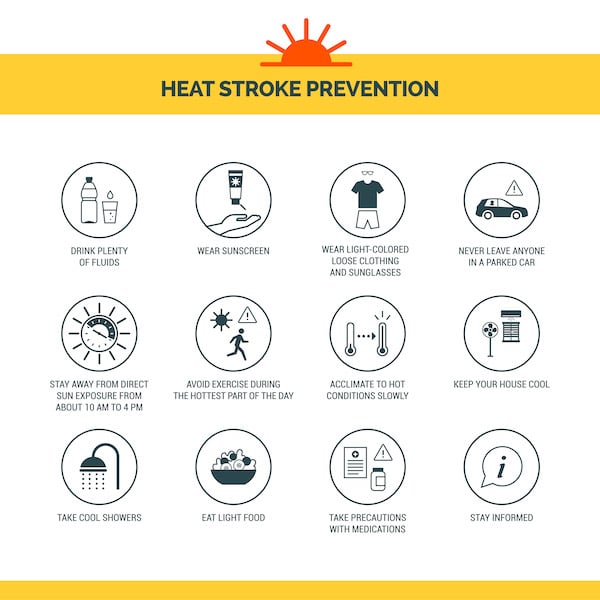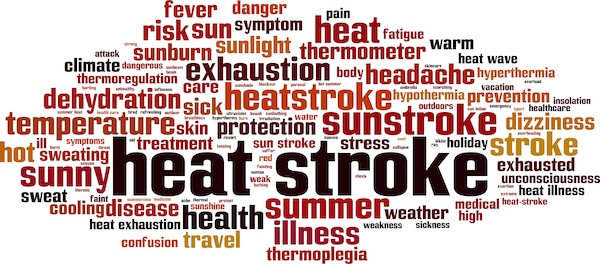Heat Stress Toolbox Talk – Quick & Easy Safety Tips for 2023

Looking for a Heat Stress Toolbox Talk that you can share with your team? Read on for quick tips and shareable information to teach your team about this important topic. We also offer a more in-depth and video-based Heat Stress Training program.
Heat illness happens to a person when they spend too much time in the (you guessed it) heat. Caused by high temperatures and high humidity, you may develop heat exhaustion, heat stress, or a more life-threatening illnesses like heat stroke.
Let’s take a look at the four most common heat exposure conditions. Then, we’ll go over who’s most at risk of heat related illness, prevention tips, and symptoms to lookout for.
What are the Most Common Heat Exposure Conditions?
Heat Rash
This condition is also known by another name – prickly heat. It’s probably the least dangerous of them all and will usually appear with a stinging irritation on the skin, making it turn red.
Heat Cramps
These are painful spasms that appear like muscle cramps. They are also involuntary and often appear during heavy exercise sessions during hot weather.
For those who suffer from the average leg cramps at nighttime, heat cramps can be more intense and painful. Electrolyte and fluid loss often contribute the most to heat cramps, so be sure to have a sports drink readily available!
Heat Exhaustion
This is the second most dangerous heat-related illness before heat stroke. It’s caused when not enough fluids enter the body paired with too many hours spent in high temperatures.
Symptoms include rapid breathing, a weak pulse, and heavy sweating.
Heat Stroke
This is one of the most life-threatening heat-related illnesses of all, and it happens when your body temperature rises above 41°C within a few minutes. Most people experience it in the summer months, too.
If you start feeling like you are having heat stroke symptoms, you will require emergency medical help. Heat stroke that is not treated immediately can be detrimental to your health and even cause death.
The symptoms will quickly damage and interfere with your vital organs, including the heart, brain, kidneys, and muscles. It can also lead to high blood pressure. The longer medical emergency treatment is delayed, the more likely you are of increasing serious conditions.
Avoiding heat stroke and heat exhaustion is the basis of any discussions, tips, etc for your Heat Stress Toolbox Talk.
Who is at Risk of a Heat-Related Illness?
No one is exempt from developing a heat-related illnesses. However, some people are more susceptible to succumbing to one of the above conditions due to extreme heat or hot weather. For instance, elderly or young people.
Those under the age of four or seniors aged 65+ are at a much higher risk of developing heat stress. Why? Because, for children, the body’s ability to adjust its own core temperature has not yet been fully developed. The reason for older adults is that the body temperature may be affected by external sources, including prescribed medications, illnesses, and other risk factors that come with older age.
Other Risk Factors That Affect A Persons Heat Tolerance:
Certain Drugs or Medications
Certain medications can compromise how well your body can remain hydrated. They can also affect whether the body can appropriately react to heat, which includes medications that:
- Treat heart problems and high blood pressure (diuretics, beta-blockers)
- Reduce symptoms of allergy (antihistamines)
- Calm you down with the use of tranquilizers
- Reduce psychiatric symptoms, including delusions (antipsychotics)
- Mental illness medication such as antidepressants can also have an impact on whether someone is more likely to succumb to symptoms of heat stress.
What’s more, there are plenty of illegal drugs, like amphetamines and cocaine, that have the ability to increase your core body temperature.
Sudden Temperature Changes
People not used to hot weather or extreme heat will be a lot more susceptible to a heat-related illnesses, especially heat exhaustion. Those traveling to a hot climate from the cold or those living in a place that has experienced a heat wave early on can also be put at risk of developing a such illness. This is because your body does not have the chance to acclimatize to the hotter temperatures.
Obesity
People who are carrying excess weight are more at risk of developing signs of heat exhaustion or other heat-related illnesses. This is because the body’s ability to regulate its core body temperature is reduced, which causes the body to actually retain more heat than is needed.
A High Heat Index
Your heat index decides how humidity and outdoor temperatures make your body feel and react in a hot environment. In a hot environment with high temperatures, cool water and rest breaks are critical to keeping your employees safe.
In high humidity, the body will find it difficult to evaporate sweat easily, which means it will have a harder time trying to cool itself down. This then makes you more susceptible to heat stress and heatstroke.
If your heat index or body temperature hits 91°F or higher, you should immediately seek precautions to stay as cool as you possibly can. You should probably even visit the emergency room if symptoms of heat exhaustion persist.
How Does the Body Temperature Stay Cool?
The human body’s process of maintaining the core temperature is called thermoregulation. It is controlled by a part of the brain called the hypothalamus. This switches on receptors in the skin and other vital organs that cause the body temperature to reduce and keep them at a healthy level.
When the body becomes too hot, it relies on sweat evaporation to stop the heat from infiltrating your system (dissipate heat). This is caused when being exposed to hot weather, humid weather, or just being in a humid/hot environment for a long time.
If the heat is entering your body quicker than the rate it is leaving it, these are warning signs that your core temperature is about to rise. And you know what that means? You’re more at risk of developing a heat injury or other heat-related illnesses.
Before we look at the symptoms of heat stress, how do we prevent heat exhaustion?

Heat Stress Toolbox Talk – Prevention
There are a number of ways you can prevent heat stress and regulate body temperature. When out and about in the hot sun, these are the best safety measures you can take:
Wear Lightweight & Loose Fitting Clothing
Your body won’t be able to stay cool if you’re wearing too much. Make sure you remove outer clothing and wear loose-fitting garments against your skin. Clothes that are too tight can cause poor circulation and stop your body from being able to cool properly.
Protect Yourself Against Sunburn
Skin irritation caused by too much sun can appear as sunburn. This is a really uncomfortable side effect of too much sun, and spending too long in it will cause your body to be unable to cool itself.
Ensure you protect yourself by wearing sunglasses, a wide-brimmed hat, and sunscreen with an SPF of 30 or more. Moist skin with lots of sunscreen will provide a barrier against your body and the sun. Those prone to heavy sweating or who have dry skin will need to apply the cream more often.
Drink Plenty of Fluids
Drinking fluids is paramount if you want to stay safe in the sun and avoid heat stress. It will help maintain your internal temperature and stay hydrated. Sports drinks along with cool water during and after exercise are good, especially during the heat. This is because, during excessive sweating periods, you will need to replace the fluids your body has lost.
Drink cool water instead of cold water, too. This is because anything too cold will compromise the body’s ability to regulate its temperature, which can cause dehydration. Basically, just remember to drink water on a regular basis. Drinking lots of fluids seems like a common sense part of any Heat Stress Toolbox Talk, but it needs to be emphasized in any training that you do.
Try and Stay in a Cool Area
If you want to avoid experiencing heat exhaustion, one of the most obvious things to do is stay indoors with the air conditioning on or find a cool place in the shade. If you don’t have AC, you can always head to public places that do, like shopping centers. Or, if you’re out, try and find a tree to sit under to avoid the heat for a while. You can also take a dip in a pool or apply cold compresses to keep yourself cool.
Take Special Measures With Medications
If you’re taking medication that can affect how well your body stays hydrated, you’ll want to take extra precautions, so you don’t experience symptoms of heat exhaustion. Family physicians and doctors will guide you on what special measures you should be taking.
Acclimatize to the Weather
Until you’re used to the heat, don’t try any strenuous exercise in it. People who are not used to lots of sun are more at risk of developing heat rash, heat cramps, muscle cramps, and other common symptoms of a heat illness. You should wait a few weeks until your body has acclimatized to the weather before you spend too much time outdoors.
Take it Easy During the Hot Parts of the Day
If you can, try and avoid being in the heat during the hottest parts of the day. Find shaded areas and drink a lot of water to avoid getting too hot. The key herr is frequent rest breaks with proper hydration. Really, this should be a no-brainer tip for any Heat Stress Toolbox Talk but it’s worth mentioning again – and again. Also, if you are in a hot environment make sure you do your best to find air circulation. Whether it’s an AC unit or a natural breeze, air circulation helps beat the heat.
If You Are at an Increased Risk, Be Careful
For those who are more vulnerable to the hot temperatures, i.e., people with pre-existing illnesses, conditions that increase your risk of heart problems, those taking medications, and even people with a history of heat-related illnesses, you’ll want to avoid the heat as much as you can.
If you fall under this category and are planning on participating in a sporting event or strenuous workout, make sure you have immediate medical attention on hand in case of an emergency. Also, remember to drink water alongside your sports drinks.

Heat Stress Toolbox Talk – Symptoms of Heat Illness
We know that heat stress or heat exhaustion can affect people in many different ways, but let’s take a look at some of the most common complaints a person can experience when suffering from heat illnesses like this one. Having someone on staff that can perform basic first aid is extremely helpful. Be mindful of the following signs and symptoms of heat stress:
Concentration Issues
When temperatures reach high levels, the blood-brain barrier starts to break down. This lets unwanted ions and proteins build up in the brain, which can cause inflammation and compromise normal functioning, hence confusion and concentration issues.
Heat Cramps and Heat Rash
We already mentioned these before, but they’re symptoms of heat illness as well as actual conditions. Heat and muscle cramps and heat rash are the mildest symptoms of heat stress. People experience painful spasms that come into fruition during or after excessive sweating or extreme workouts in high temperatures. Rashes can be found on all areas of the body, including the upper chest, lower chest, arms, legs, and neck.
Nausea and Vomiting
When the body loses vital fluid through sweating, people can become dehydrated if they don’t replace the liquids with water or other drinks. This can cause nausea and actual vomiting and other heat related physical problems.
Fainting
This is caused when blood flow to the brain is reduced. Healthcare professionals may need to treat high blood pressure as well as heat exhaustion if a person faints. This is because as well as reducing brain blood flow, heat also increases the blood flow to the skin, which can cause blood pressure to drop.
Severe Thirst
This is one of the final stages of heat exhaustion, as your body is dehydrated and on its way to more dangerous illnesses like heat stroke. This water depletion can be fatal if you don’t act immediately, so if you want to avoid the emergency room, make sure you stay hydrated with cool water! If you haven’t noticed the issue of hydration has come up several times and for good reason. Any Heat Stress Toolbox Talk should push the idea of drinking a lot of cool liquids among your crew. Your employees need to hear it over and over again.
Swollen Ankles/Swelling in Hands and Feet
Another heat exhaustion symptom is the swelling of ankles, hands, and feet. In high heat, your body cools itself (or tries to) in different ways, and one of the ways it does it is by constricting blood vessels. This makes it harder for the body to transport blood back to the heart, and when you add gravity to the mix, this fluid moves down to your feet, ankles, and hands, causing swelling.
Avoid Heat Exhaustion and Other Heat Illnesses
You really need to look after yourself and your co-workers during hot weather, as too much sun exposure can cause you a lot of damage. By taking note of the above symptoms, following the prevention methods, and just generally trying to avoid direct sunlight as much as possible, you’ll be able to stay safe in the hot weather! We hope this Heat Stress Toolbox Talk gave you some practical education and tips and is a benefit to your Team.